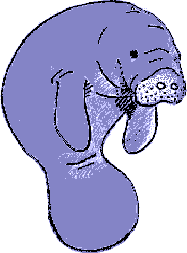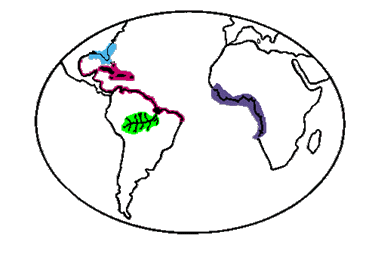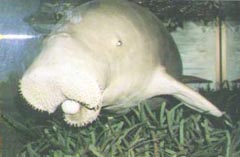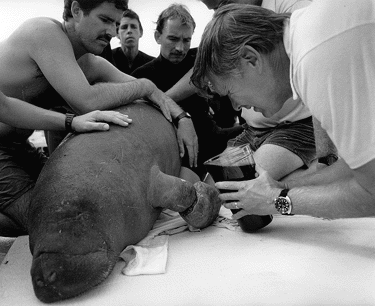


Introduction
Long, long ago, sailors thought sea cows were mermaids. Even Christopher Columbus thought so! Many people call them sea cows. They can grow to be 15 feet long and weigh over 2,000 pounds. They are the huge but gentle creatures.
Where Sea Cows Live

1. All living Sea Cows are found in warm tropical and subtropical waters.
2. The West Indian Sea Cow lives thoughout the tropical and subtropical western North and South Atlantic and Caribbean waters.However, the Sea Cow's numbers have been greatly reduced.Today the West Indian Sea Cow is listed as an endangered species thoughout its range.
a. The range of the Florida sea cow is primarily penisular Florida, but extends as far north as Virginia and as far west of Mississippi.
b. Antillean sea cows have a patchy distribution throughout the Caribbean including Mexico, southern Texas, and northeastern South America. The southern range extends through Central and South America to Brazil.
c. West African sea cows range from Senegal to Angola, on the west coast of Africa.
d. Amazonian sea cows are the only species of manatee confined to fresh water. They inhabit the Amazon Basin, mostly in Brazil. They are uncommon and close to extinction in Ecuador, Peru, and Columbia.
These are some places where sea cows live.

Breeding 
Female sea cows give birth underwater to a single calf every three to
seven years. Birth takes place in shallow water and the baby sea cow is able to swim to
the top of the water for its first breath. Baby sea cows are about 100 to 120cm long and
weigh 20 to 30 kg. The calf stays with its mother, drinking milk from her teats and
following close by until 18-24 months of age.
Sea cows reach adult size between 9 and 17 years of age, and have a life span similar to
humans,if they are left alone.
Physical Description
Sea cows may reach 3m in length and weigh almost 500 kgs. They have a thick layer
of fat giving them a distinctly rotund posture, small paddle-like flippers positioned far
forward on the body and a broad, flattened, powerful tail that resembles the tail of
whale.
The ochre brown skin appears smooth, but a really close view reveals a rough surface
covered in pits from which grow short, thick hairs. They have 2 nostrils near the top of
their heads on a "fleshy lip", which can curl up to make breathing easier on the
surface.
This is a close up picture of a seacow's mouth.

How Many Sea Cows are there?
Arabian (Persian) Gulf hosts the world's second largest population of sea cows,
thought to number at least 5,000 to 6,000. Red Sea estimate is about 4,000 East Africa
from Somalia down to Mozambique, occur in hundreds, Pacific Ocean Vanuatu (estimated
population 400), Palau (under 200), the Solomons etc. Southern Asia very small numbers in
Indonesia, Malaysia, Thailand, Myanmar, Papua-New Guinea and the Philippines.
Endangered
Sea Cows
1. All species of sea cow are protected to some extent by national or local acts in every country they occupy.
2. Federal and state laws have been passed to protect the sea cow.
a. Federal laws prohibit hunting, capturing, killing, or harassing these animals. These laws include the Marine Mammal Protection Act of 1972 and the Endangered Species Act of 1973.
b. The Florida sea cow Sanctuary Act of 1978 is state legislation establishing Florida as a sanctuary for sea cows.
3. West African sea cows are protected under Class A of the African Convention of Nature and Natural Resources, signed by 38 African countries.
4. Amazonian sea cow hunting has been prohibited since 1973.
5. The Convention on International Trade in Endangered Species of Wild Fauna and Flora (CITES) is an international treaty developed in 1973 to regulate trade in all wildlife species. All species of sirenians are protected by this tre
Predators 
1. Sharks, alligators, or crocodiles may occasionally attack the West Indian sea cow.
2. Crocodiles and sharks sometimes prey on West African sea cow.
3. Jaguars, caimans, and sharks prey on the Amazonian sea cow.
Causes Of Death
a. Sea cows are very susceptible to cold weather. It's not unusual for many to die during extremely cold weather. In 1990, 47 manatees died due to cold weather.
b. Amazonian sea cows become concentrated in confined areas when lakes dry up. They are then susceptible to starvation and predation.
c. As in any animal population, a variety of diseases and parasites can be responsible for sea cows deaths.
a. Boat-related accidents.
Due to their dark color and because they are slow swimmers,sea cows are difficult
to see in the water. Many sea cows are injured and killed by propellers and hulls of speed
boats. Collisions with boats and barges is the largest human-related factor causing sea
cow deaths.
b. Flood gates.
As sea cows swim upstream, they encounter flood gates and navigation locks. When flood gates are left partially open,sea cows sometimes swim through them. They may become trapped in the water current from the upstream side and drown. The remote controlled flood gates have also crushed sea cows.
c. Navigation locks.
d. Poaching and vandalism.
In spite of the fact that sea cows are legally protected, poachers and vandals are responsible for sea cow deaths. In some areas sea cows are hunted for food. Others are victims of harassment.
e. Accidental entanglement.
Florida sea cows have been found with fishing lines or crab trap lines wrapped around them. These materials can wrap tightly around the sea cow's flippers, cutting off the circulation and causing serious infections.
This is a picture of a sea cow rescue.

f. Habitat destruction.
Since the 1950s, destruction of the natural habitats of many coastal animals is
accelerating at an alarming rate. Much of the suitable sea cow habitat in Florida
(seagrass beds, salt marshes, and mangroves) has been destroyed.
g. Death increases.
Between 1987 and 1991,sea cow mortality has increased in Florida. The following table gives the approximate number of sea cow deaths for five years in the southeastern region of the United States
| year | 1987 | 1988 | 1989 | 1990 | 1991 |
| sea cow deaths | 120 | 135 | 174 | 218 | 181 |
Summary
I think that Sea Cows are great creatures. I think people should not hurt the sea cow because once there gone we can't get them back and it would be a shame to loose these beautiful creatures.
Resources :
www.seaworld.org/infobook.html
www.ozemail.com.au/~man7/whales/wsounds.html
| Hallett Cove South Primary School Information: Meagan Learey Editor: HTML Constructed by Meagan Learey. |
Kamo Elementary School | Central Elementary School |